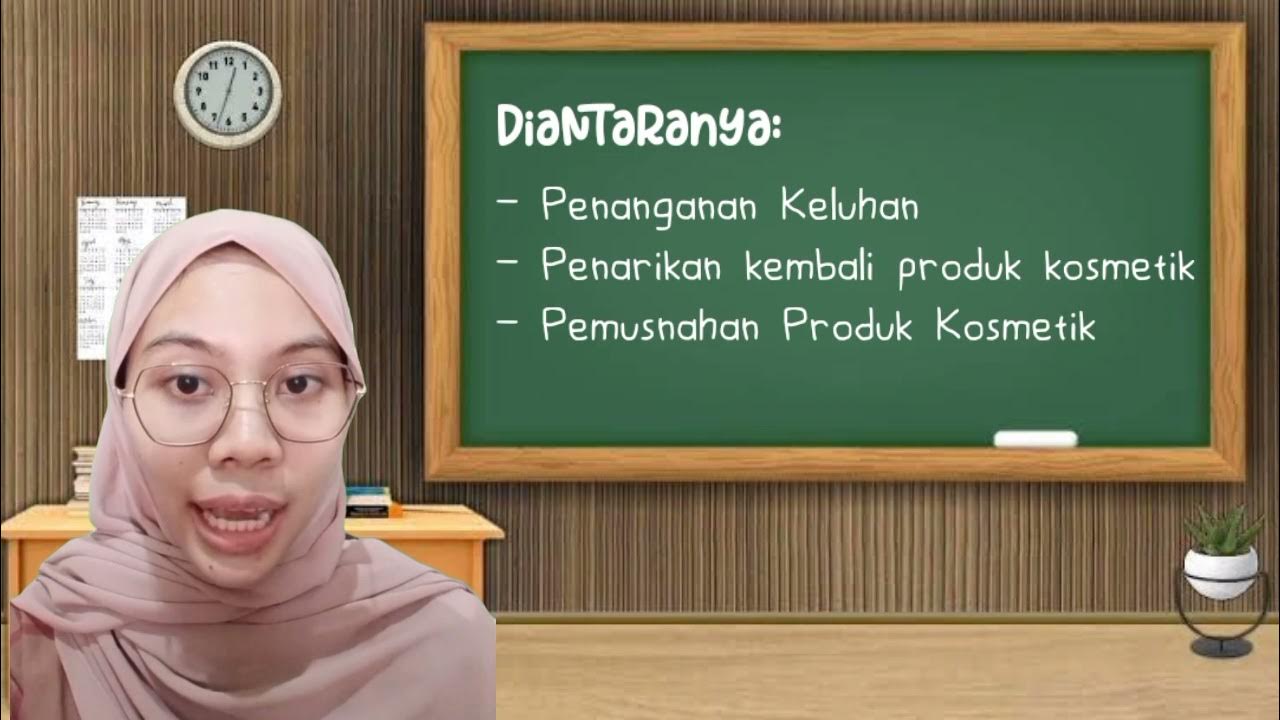Pengertian CPOB, CPKB, & CPOTB
Summary
TLDRThis video provides an in-depth explanation of the Good Manufacturing Practices (GMP) regulations for pharmaceuticals, cosmetics, and traditional medicines in Indonesia. It covers the CPB (pharmaceuticals), CPKB (cosmetics), and CPOTB (traditional medicine) frameworks, highlighting their purpose to ensure product safety, quality, and efficacy. The video outlines the principles, guidelines, and certification processes required for manufacturers to comply with these standards, emphasizing the importance of consistent quality control, hygiene, qualified personnel, and proper documentation in the production process. It serves as a comprehensive guide to regulatory requirements for these industries.
Takeaways
- 😀 The CPB (Good Manufacturing Practices for Drugs) in Indonesia was first implemented in 1988 and has undergone several revisions, with the latest version in the POM Agency Regulation Number 34 of 2018.
- 😀 CPB is a method that ensures drug products meet quality standards, focusing on aspects like raw materials, packaging, production processes, and personnel.
- 😀 The CPB principle aims to avoid contamination, errors, and mixing of products, ensuring consistency in drug manufacturing, such as maintaining the same color for a tablet batch.
- 😀 The key goal of CPB is to guarantee that drugs are safe, effective, and meet the intended use without causing harm to patients.
- 😀 CPB contains 12 chapters, covering areas like quality systems, personnel qualifications, production processes, equipment, self-inspection, complaints, documentation, and validation.
- 😀 The cosmetic industry also follows a similar set of regulations called CPKB (Good Manufacturing Practices for Cosmetics), divided into Group A and Group B industries based on their responsibilities and technical expertise.
- 😀 CPKB aims to protect the public from unsafe cosmetic products, increase the value of Indonesian cosmetics, and ensure consistent quality in the cosmetic industry.
- 😀 Traditional medicine manufacturing follows CPOTB (Good Manufacturing Practices for Traditional Medicine), which ensures products meet health standards and includes requirements for building facilities, personnel, hygiene, and packaging.
- 😀 CPOTB includes aspects like quality control, periodic self-inspection, and documentation of production history and product batch numbers to ensure compliance and product safety.
- 😀 To obtain a CPOTB certificate for traditional medicine, businesses must meet administrative and technical requirements, including facility plans, system documentation, and a commitment statement.
Q & A
What is CPoB, and why is it important in drug manufacturing?
-CPoB stands for Good Manufacturing Practices for Drugs, which ensures that drugs and drug ingredients are produced in a way that guarantees their quality, safety, and efficacy. It is crucial for maintaining consistency and meeting regulatory requirements in the pharmaceutical industry.
When was CPoB first implemented in Indonesia?
-CPoB was first implemented in Indonesia in 1988 and has undergone several revisions. The most recent version is outlined in the POM Agency regulation No. 34 of 2018.
What are the key components of CPoB that ensure drug quality?
-The key components of CPoB include the quality of raw materials, packaging materials, production processes, building facilities, equipment, and qualified personnel. Each component plays a vital role in ensuring the final product meets required standards.
What is the purpose of CPKB in the cosmetic industry?
-CPKB ensures that cosmetic products meet safety and quality standards. It protects the public from harmful products and aims to improve the competitiveness of Indonesian cosmetic products in the global market.
How is the cosmetic industry classified under CPKB?
-The cosmetic industry is divided into two groups under CPKB: Group A, which requires advanced facilities and a pharmacist as a technical supervisor, and Group B, which requires basic facilities and a pharmaceutical technical personnel.
What are the general objectives of CPKB?
-The general objectives of CPKB are to protect the public from harmful cosmetic products and to increase the competitiveness of Indonesian cosmetics in the global market.
What does CPOTB stand for, and which sector does it apply to?
-CPOTB stands for Good Manufacturing Practices for Traditional Medicines. It applies to the production of traditional medicines, ensuring they meet safety and quality standards similar to those for drugs and cosmetics.
What are the core requirements for CPOTB compliance?
-CPOTB compliance includes requirements for qualified personnel, clean facilities, proper sanitation, safe equipment, controlled packaging, and regular self-inspections to ensure product quality.
What steps must a company take to obtain a CPOTB certificate?
-To obtain a CPOTB certificate, companies must submit both administrative and technical documents, including application letters, payment proofs, and layout plans. These documents demonstrate that the company meets all CPOTB requirements.
What are the 12 chapters included in the CPoB regulation?
-The 12 chapters in the CPoB regulation include: 1) Pharmaceutical Industry Quality Systems, 2) Personnel, 3) Buildings and Facilities, 4) Equipment, 5) Production Processes, 6) Storage and Delivery, 7) Quality Control, 8) Self-Inspection, 9) Complaints and Recalls, 10) Documentation, 11) Validation Activities, and 12) Qualification and Validation.
Outlines

このセクションは有料ユーザー限定です。 アクセスするには、アップグレードをお願いします。
今すぐアップグレードMindmap

このセクションは有料ユーザー限定です。 アクセスするには、アップグレードをお願いします。
今すぐアップグレードKeywords

このセクションは有料ユーザー限定です。 アクセスするには、アップグレードをお願いします。
今すぐアップグレードHighlights

このセクションは有料ユーザー限定です。 アクセスするには、アップグレードをお願いします。
今すぐアップグレードTranscripts

このセクションは有料ユーザー限定です。 アクセスするには、アップグレードをお願いします。
今すぐアップグレード関連動画をさらに表示
5.0 / 5 (0 votes)






